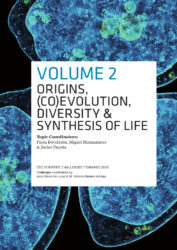Coordination: Paola Bovolenta; Miguel Manzanares; Javier Buceta
Publication date: 10 de marzo de 2021
Language: English
Categories: Life Sciences
Collection: CSIC Scientific Challenges: Towards 2030
Number of pages: 185
Additional data: CSIC Scientific Challenges: Towards 2030, Vol. 2
Presentation session available at CSIC Comunicación
This is volume 2 of the 14 “CSIC White Papers” that define its strategy until 2030.
The book contains 8 challenges. The challenge “The origins of life: from chemistry to biology” (pages 20 to 53 of this PDF) has been coordinated by Carlos Briones Llorente (CAB) and co-coordinated by Izaskun Jimenez-Serra (CAB).
Other CAB researchers who have participated in this challenge are: Jacobo Aguirre, David Hochberg, Eva Mateo Martí and Marta Ruiz Bermejo.
How life appeared on Earth and how then it diversified into the different and currently existing forms of life are the unanswered questions that will be discussed this volume. These questions delve into the deep past of our planet, where biology intermingles with geology and chemistry, to explore the origin of life and understand its evolution, since “nothing makes sense in biology except in the light of evolution” (Dobzhansky, 1964). The eight challenges that compose this volume summarize our current knowledge and future research directions touching different aspects of the study of evolution, which can be considered a fundamental discipline of Life Science. The volume discusses recent theories on how the first molecules arouse, became organized and acquired their structure, enabling the first forms of life. It also attempts to explain how this life has changed over time, giving rise, from very similar molecular bases, to an immense biological diversity, and to understand what is the hylogenetic relationship among all the different life forms. The volume further analyzes human evolution, its relationship with the environment and its implications on human health and society. Closing the circle, the volume discusses the possibility of designing new biological machines, thus creating a cell prototype from its components and whether this knowledge can be applied to improve our ecosystem. With an effective coordination among its three main areas of knowledge, the CSIC can become an international benchmark for research in this field.







